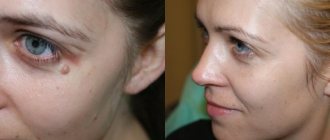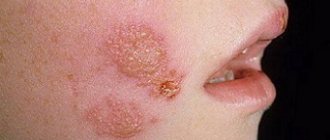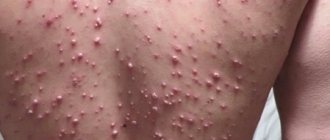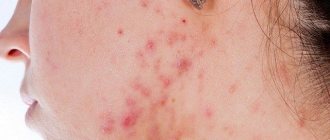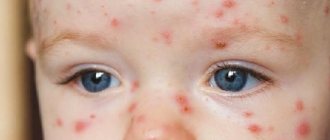Warts on the face are a group of dermatological diseases that are accompanied by the appearance of papules.
Their feature is their long existence.
The rash does not go away after a few days or even after a few months.
It can exist for years.
Only some people experience self-healing.
Others have to remove warts on their faces to improve their appearance.
Causes of warts
Viral warts are most common on the face.
The main reason for their formation is the papillomavirus.
It enters the skin and causes excessive cell division.
As a result, small benign tumors form.
This virus is transmitted by contact.
For infection, an important condition is the presence of damaged epidermis.
Therefore, warts and papillomas on the face appear more often in men.
After all, they regularly shave their beard hair.
The blade causes microdamage to the skin.
Through these defects, a virus enters it, causing warts to grow on the face.
They look unattractive.
In addition, they can be damaged during shaving.
Other types of warts on the face are less common.
There are hereditary diseases that cause their multiple occurrence.
Also, a number of pathologies lead to the formation of a rash that looks like warts.
Which removal method should you prefer?
There are mechanical, chemical and physical methods. Self-removal of warts with chemicals (solcoderm, celandine) often leads to incomplete removal with possible dissemination of the process, leaving larger and more noticeable scars. In addition, for single warts, the price of drugs is almost equal to the cost of removing a wart in a clinic.
Today, the “gold standard” is removal using an ablative laser.
The CO2 laser used to remove warts in our clinic has the following advantages:
- Thanks to the small thickness of the beam (200 µm), it is possible to precisely influence the tissue;
- The laser wart removal procedure is radical and one-time;
- Lack of direct contact of the device with the wound, asepsis, hemostasis (the wound does not bleed);
- Favorable effect on regeneration, rapid wound healing, virtually no scar.
Vulgar warts
They form on the face and hands in both children and adults.
They are also called common or simple warts.
Morphological elements have the appearance of papules.
They can have different sizes.
Sometimes these are small warts on the face, the diameter of which does not exceed 1-2 mm.
There are also larger sizes – up to 1 cm.
In immunodeficiency states, they can grow to impressive sizes.
Upon inspection, it is noticeable that the surface layer of the element is covered with cracks.
Hyperkeratosis is observed on it.
That is, a layer of dead cells.
As a result, simple warts have a hard surface.
As a rule, they do not differ in color from the surrounding skin.
Although in some cases these may be red warts on the face.
At their location, the skin pattern is lost.
However, when the formation disappears, the relief of the epidermis is restored.
If a doctor examines a formation on the face under a magnifying glass, the warts are covered with black or brown dots.
They are capillaries (small blood vessels) that are blocked by blood clots.
This symptom is pathognomonic.
That is, it occurs only in warts.
Detection of this symptom makes it possible to differentiate them from other skin formations.
For example, from keratomas or skin tumors.
As a rule, small warts on the face are round in shape.
If they reach large sizes, they can acquire a polycyclic form.
More often, warts are single.
Less often they are located in groups of several pieces.
At the same time, no systematicity is observed.
The arrangement of the morphological elements of the skin is chaotic and asymmetrical.
If a wart on the face is removed poorly, new formations may appear in the same area.
They are located around the therapeutic area.
Symptoms
A flat wart appears as a small papule up to 5 mm, slightly rising above the epidermis. The nodule can be either round or irregular in shape. It is smooth to the touch, with clearly defined boundaries. During the rash period, several elements appear, separated from each other. Neoplasias do not tend to merge. In the wart area, the skin is smooth and shiny, without cracks, keratinization, or growths.
A characteristic feature is the absence of a skin pattern and itching on the surface of the formation. The color of the papule matches the shade of healthy skin, sometimes it can change to light beige or pale pink. Most often, flat formations appear on the neck, face, back of the hands, and the outer area of the feet. This localization is associated with increased trauma to these areas of the body. There are a large number of sebaceous glands on the face, which often become clogged and inflamed, which also makes this area a risk area. Juvenile neoplasms never affect the soles and palms.
The main danger of flat warts is their injury and inflammation. Constant irritation of neoplasia opens the gates for infection and increases the risk of cell degeneration.
Lots of warts
Sometimes a person develops a large number of warts on his face.
The reasons for this may be a disease called epidermodysplasia verruciformis.
Rashes appear that look like flat warts.
Most often they are quite large.
Arranged in groups.
The total number of warts is large.
They often merge with each other.
In appearance, such rashes can sometimes be confused with senile warts or solar keratosis.
Unlike many other types of warts, these pose a real threat to life.
Because they can develop into squamous cell carcinoma.
It is not always diagnosed in the early stages.
Considering that a large number of warts appear, it is very difficult to notice that any of them has changed shape or outline.
First, cancer develops locally.
Over time it can become invasive.
The color of such formations can be black or brown.
Hypopigmentation is less common.
In this case, the warts on the face turn white.
They have either a round or oval shape.
Sometimes warts reach large sizes and merge, forming a “geographic map”.
It is on the face that these formations most often transform into a malignant tumor.
Although they can also be located on the body and limbs.
Like simple warts, epithelial dysplasia is localized in areas of scratching and scratching.
Treatment
Juvenile warts have a tendency to disappear on their own when the patient’s condition is stabilized and the immune system is strengthened. Sometimes this takes a lot of time, and an aesthetic defect forces one to resort to radical methods to get rid of the problem. The main criterion when choosing a method is to guarantee safety, effectiveness and absence of scars.
Taking into account the requests of patients, the optimal solution is radio wave treatment with the Surgitron device. The wave penetrates only to the depth necessary to remove formations. At the same time, coagulation of blood vessels occurs, which minimizes blood loss. The duration of the procedure is 15-20 minutes. During this time, the doctor manages to remove several flat warts at once.
To prevent new growths, it is recommended to undergo a course of antiviral and immunomodulatory therapy. This allows you to achieve stable remission and put the virus into a dormant state.
Features of diagnosing warts in children
To make a correct diagnosis, a comprehensive examination is carried out. It includes:
- physical examination. The doctor talks with the child and parents and examines the affected area of skin. In the process of collecting anamnesis, the duration of complaints and the likelihood of contact with an infected person are determined. The doctor determines the location and nature of the tumor;
- dermatoscopy. The study is prescribed if the clinical picture does not allow an accurate diagnosis to be made as a result of a physical examination. Warts in children have the shape of a dense tubercle with a large number of capillaries;
- biopsy. The study is prescribed if it is necessary to clarify the nature of the growth and differentiate it from malignant neoplasms. On section, the wart looks like a benign epithelioma.
How to treat warts in children?
Various therapies are currently used
| Conservative treatment | Therapy is aimed at suppressing pathogenic microflora and raising the body's defenses. There are no special drugs designed exclusively to combat the papilloma virus. The patient is prescribed broad-spectrum antiviral agents in combination with probiotics and vitamins. |
| Chemical destruction | Local medications are prescribed, most often in the form of a cream. The course of therapy can last 2–3 months. Additionally, salicylic acid-based medications may be prescribed. The treatment regimen is developed by the doctor individually, taking into account the clinical picture. |
| Physical destruction | Depending on the location, size and shape of the skin growth, the following procedures may be prescribed:
This is a minimally invasive method of removing skin growths, which consists of a targeted effect of radio waves on the affected area. The procedure is highly effective and can be used to treat warts of various sizes and locations. |
| Surgery | Surgical intervention is indicated when there is a high risk of the tumor degenerating from benign to malignant. The following surgical treatment methods are used:
|
Complications
Warts in children can spread to healthy areas of the body. With strong growth of plantar formations, a significant part of the foot can be affected, which entails pain.
Warts in children on exposed parts of the skin cause psychological discomfort and embarrassment.
Skin growths caused by aggressive types of papillomavirus (13, 18, 3), in the absence of timely treatment, have a risk of degeneration into malignant neoplasms.
Forecast and preventive measures
With timely treatment of warts in children, the prognosis is favorable in most cases. However, it is important to consider that complete recovery cannot be guaranteed by any method of therapy. On average, relapses are possible in 10% of cases.
To prevent the reappearance of warts, you must adhere to the following recommendations:
- Use personal hygiene products and do not allow your child to take someone else’s.
- You should not scratch warts to avoid accidentally transferring the virus to healthy areas of the body.
- You should not try to solve the problem yourself. Self-medication can lead to serious complications.
- Do not neglect hardening, organize a daily routine with good nutrition and rest.
- Do not allow children to walk barefoot in public places.
- If any skin damage occurs, treat it with antiseptic compounds as soon as possible.
- Remember to regularly check your child's body (especially the feet) for skin tags.
If you need advice from an experienced pediatrician and dermatologist on the treatment of warts in children, contact the Miracle Doctor medical center. To make an appointment, please call the phone number listed on the website or use the feedback form.
